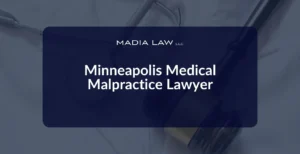
You trusted a medical professional with the most important thing in the world: your health or the health of a loved one. But they didn’t live up to your trust, and now you or someone you love is hurt.
Your condition got worse, or someone you love may even have died. You deserve the truth.
The trial lawyers at Madia Law can help.
We understand that medical malpractice causes real pain to victims and their families. We understand that you’re looking for answers. And we understand that you need a fierce advocate to get you compensation for what happened and help you deal with the new challenges you’re facing.
Contact our Minneapolis medical malpractice lawyers today and start the process of getting answers – and justice.
What is medical malpractice?
Medical malpractice is when a medical professional like a doctor or nurse doesn’t meet the required standard of medical care, and someone gets hurt or killed as a result. Put another way, medical malpractice occurs when a doctor fails to do what a reasonably careful doctor would have done in the same situation.
For a legal consultation with a Personal Injury lawyer serving Minneapolis, call 612-349-2729
How do you evaluate a malpractice claim?
It’s not medical malpractice any time something bad happens involving a doctor or nurse. We have to first understand whether the doctor deviated from the standard of care. That is, we need to figure out: would a reasonably careful doctor have done anything differently? If yes, then this could be medical malpractice. But we also need to evaluate and understand causation: did this doctor’s malpractice cause your injuries, or would the injuries have happened no matter what?
We never want to encourage someone to file suit if we’re not confident that we can win the case and make it worth that person’s time and energy. And we don’t want to give someone false hope by telling them that they have a case, if we’re not confident that the doctor deviated from the standard of care and caused harm. Our job is to be honest with people and tell them the truth.
So how do we figure it out? The first thing we’ll do is order all of your medical records. We’ll review them and consult with an expert physician in the relevant field – sometimes more than one – to determine whether your doctor or nurse deviated from the accepted standard of care. We’ll consult with more experts to determine whether your doctor’s malpractice caused your injuries.
If the answer to these questions is yes, then we’ll probably tell you that you have a strong case and should move forward. If not, we’ll tell you that, too. We’ll tell you the basis for our opinion, and also give you the contact information of other medical malpractice attorneys we trust so you can get a second opinion.
Minneapolis Medical Malpractice Lawyer Near Me 612-349-2729
Who can I sue in Minnesota for medical malpractice?
So, of course you can sue the doctor or nurse or other medical professionals who committed malpractice. But they may not have enough insurance to fully cover the damages that they caused. It’s important to think about other potential defendants as well.
Hospitals and health clinics that employed the doctor or nurse can also be held legally responsible for malpractice in many instances. For example, hospitals and clinics are legally responsible for the acts of their employees, including doctors and nurses. Many hospitals will argue that the doctor in question wasn’t technically an employee, but was instead operating as an independent contractor who just had hospital privileges. But there are legal tests and factors that courts weigh when determining whether a doctor was an employee or contractor. We can use discovery to get valuable information – including the degree of control exercised by hospital, practice requirements and guidelines, and degree of supervision – to create a fact question on whether the doctor was an employee or contractor. The contract between the hospital and doctor is not dispositive of the question, and frankly, has minimal relevance.
If we can show that the doctor or nurse was an employee of the hospital, then the professional’s malpractice is treated as an act by the hospital. And the hospital can rightly be held responsible to ensure that your losses are fully covered.
Another way to hold hospitals and clinics responsible is to demonstrate that the hospital was negligent in its policies and procedures as compared to the standards set by a reasonably safe and effective health care center.
Click to contact our personal injury lawyers today
What is the statute of limitations for medical malpractice in Minneapolis, MN? How long do I have to start a medical malpractice suit in Minnesota?
A statute of limitations is the amount of time that the law allows you to bring a lawsuit after a negligent act. Generally speaking, you must bring suit within that amount of time or you lose your right to sue over the malpractice.
In Minnesota, you’ve got 4 years from the date of the medical malpractice to sue, with a few exceptions.
The first exception is if the malpractice results in death of a patient, in which case you’ve only got 3 years from the date of the malpractice.
The second exception – a major exception – is called the “discovery rule.” In some, limited situations, the doctor’s negligence or harm isn’t apparent right away. If a patient can show that the medical error wasn’t discovered – and could not have reasonably been discovered – at the time the mistake was made, then the 4 year statute of limitations clock might be paused.
And the third exception is if the injured patient was under the age of 18 at the time of the medical malpractice. In that case, the 4 year clock is paused and the deadline to file suit is extended until 1 year after the patient’s 18th birthday.
If you think you might have a medical malpractice issue, you should contact a Minnesota Medical Malpractice Lawyer right away for an analysis of how much time you have to bring your case.
Complete a Case Evaluation form now
Are there any special requirements to bring a medical malpractice claim in Minnesota?
Yes.
First, Minnesota requires plaintiffs bringing a medical malpractice case to serve an affidavit stating that:
- The facts of the case have been reviewed by the plaintiff’s lawyer, along with a qualified expert in the applicable standard of medical care; and
- In the expert’s opinion, the defendant health care provider deviated from the correct medical standard of care, and that deviation caused injury to the patient.
The affidavit is usually completed and signed by the plaintiff’s medical malpractice lawyer. It needs to be served right at the outset of the case, along with the Summons and Complaint (the legal document saying the facts of what happened and why we believe the doctor committed malpractice).
Second, the medical malpractice plaintiff in Minnesota must serve another affidavit that states:
- The identity of each medical expert the plaintiff expects to use as an expert witness on medical malpractice or causation of injuries;
- The substance of the facts and opinions of those experts; and
- A summary of the basis for each of those expert’s opinions.
Each expert must sign this affidavit, and it needs to be served on the defense within 180 days of initiating suit.
If you don’t comply with these requirements, a court can dismiss your case.
Please consult with a Minneapolis Medical Malpractice Lawyer today if you need help bringing a medical malpractice case.
How much is my medical malpractice case worth?
You’re asking the right question. You should absolutely have an idea of what you’re fighting for before you get into a medical malpractice suit. Your Minnesota medical malpractice attorney will go over this with you in detail, but here are some basic concepts.
The value of your case depends on a number of different factors, but the most important are:
- How bad was the doctor’s negligence? If your doctor or nurse messed up badly, then they will have a very hard time defending their actions in front of a jury. That increases the value of your case.
- How bad were you injured? Serious, life-altering injuries, or death, demand very high settlements or verdicts, to compensate for such a great loss.
- What is your tolerance for risk? Like many things in life, increased risk carries the chance of increased reward. If you are willing to go the distance and go all the way to trial, that will generally drive higher settlements. And even if the case doesn’t settle, the jury has the chance to render the final verdict.
There are no caps on damages in Minnesota. You are eligible to recover a number of different types of damages for medical malpractice, including:
- Medical bills and costs
- Lost income
- Past bodily and mental harm, including:
- Pain
- Disability
- Disfigurement
- Embarrassment
- Emotional distress
- Future bodily and mental harm, including:
- Pain
- Disability
- Disfigurement
- Embarrassment
- Emotional distress
What should I do if a family member died because of medical malpractice?
There’s a procedural requirement in Minnesota where you first need to get someone appointed as trustee for the next of kin. That trustee is empowered to bring the wrongful death case on behalf of the next of kin.
The basic elements of the medical malpractice case remain basically the same: we must prove that the physician was negligent in providing medical care, and that negligence caused your loved one’s death.
In a wrongful death case, the next of kin are entitled to damages for their suffering due to the loss of their loved one, including the loss of:
- Advice;
- Comfort;
- Financial assistance (such as if the loved one contributed money or living expenses to the next of kin, or would have done so had he lived);
- Non-financial assistance (such as if the loved one did chores or tasks for the next of kin, for things like mowing the lawn, or shoveling the driveway, or cleaning the house);
- Companionship; and
- Protection.
How much will a medical malpractice case cost?
Our guarantee at Madia Law is that we rise and fall together with our clients: we only collect a fee if you recover compensation. We’re a contingency based firm, which means that we will invest our time and resources in your case for years without collecting a penny from you. If we win or get you a settlement, then you pay us a contingency fee from that amount. If we don’t get you anything, you don’t owe us anything.
Start the conversation. Call or message us today.
What is the process for a medical malpractice claim in Minnesota?
First, get a medical malpractice lawyer. Interview a few, and choose the one that feels best to you.
Your lawyer will get your medical records and review them with experts. If we think you have a case that will be worth your time and energy to pursue, we’ll tell you and get the case going with a Complaint and Certificate of Expert Review. Shortly thereafter, we’ll send affidavits from our experts stating their opinions to the defense.
We’ll then start discovery, which generally takes between 9 months and a year. During this time, we’ll request documents from the other side, conduct depositions, and sharpen our expert reports.
At the end of discovery, the defense will usually make a motion to exclude our experts from trial, or a motion for summary judgment (to dismiss our case), or both. We’ll have done the leg-work in discovery to beat these motions. Sometimes we may make a motion to exclude the defense expert, but I often like to let them testify in front of a jury (even when I could probably win a motion in limine), because I want the jury to see the defense expert squirm to try to justify his absurd opinions in defense of the doctor.
Then we get to go to trial.
You can expect, overall, an 18-24 month process if your case goes all the way through trial. The case can settle at any time, from Day 1 through the end of trial, if both sides agree on terms. We have found that the best way to secure fair compensation in settlements for our clients is to make clear to the defense that we’re ready for trial, and we’re going to win.
What should I do if I was a victim of medical malpractice in Minneapolis, MN?
Call our Minneapolis Medical Malpractice Lawyer today at 612.349.2729, or fill out our form below. You need help from someone who knows what they are doing, to: a) get all of your medical records; b) get them to an expert for evaluation; c) do a legal analysis of your case; and d) get your case served within the statute of limitations, along with the Certificate of Expert Review.
Call 612-349-2729 or complete a Case Evaluation form









